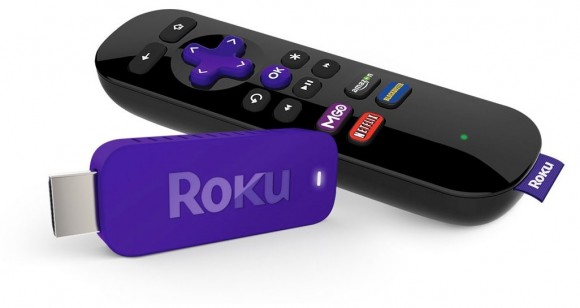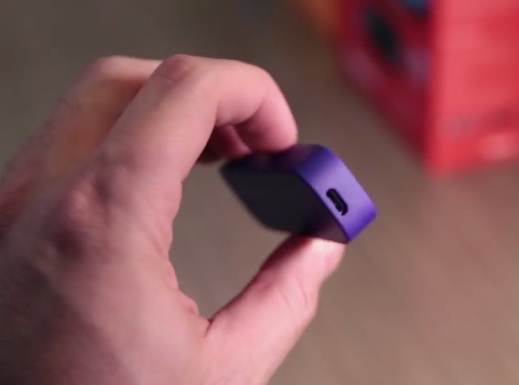
As we revealed about a week ago, Roku will shortly release an updated Streaming Stick. And, by way of TechHive, the $50 price point, retirement of MHL, and power via microUSB details have all been confirmed.

Sadly, there’s no mention of Miracast screen mirroring functionality… but Roku’s mobile apps will soon inherit the streamer’s universal search capabilities. The “New” Roku Streaming Stick (HDMI Version) is now available for pre-order with shipping and store availability expected in early April. While the new HDMI Roku Streaming Stick will replace the Roku 1 on Best Buy’s shelves, as indicated by BBY Insider, that $50 model will remain in Roku’s lineup (for those without HDMI).
Amazon Instant via AirPlay is getting old. Think I might pick up one of these new Roku sticks and unload my Apple TV. Until the next one is released anyway… or that incoming Amazon streamer! And some good news… YouTube is listed as an app on the new Stick.
YouTube!!
I may be old-fashioned but I really like on-screen interface of Roku vs the on-the-iPad functionality of Chromecast.
I’m the opposite. I prefer the Chromecast style of control to adding yet another remote to the mix. I wonder if any of the new devices will start setting themselves up as Chromecast receivers. Would be nice to have the extra functionality of the Roku with the ability to cast to it like it is a Chromecast.
Also, the last of ethernet takes away one of my personal advantages of Roku over Chromecast.
At $50, I imagine it doesn’t use the new roku3’s fast CPU. I suggest passing. That speed is WELL worth the doubled price, and the roku3 is light enough to stick on the back of your TV with velcro tape anyway.
I dunno… this seems like the perfect device for my mom, who probably wouldn’t appreciate the speed but could appreciate one of these on both TVs for the price of one R3. (I’m quite satisfied with my Roku 3.)
Dude, everybody appreciates speed!
Two TVs are better than one; if you’re choosing between two sticks and one roku3 I agree, go with the two sticks. But if it were me, I’d buy two roku3s.
So this functions both as a ‘caster’ & a regular Roku box?
And please tell me I can re-program that dedicated Blockbuster button to something else!
Bill, the main difference is in the form factor not in the function. The Roku app does allow you to cast personal photos and videos stored on a mobile and both Netflix and YouTube are using DIAL (like Chromecast), but again it’s mostly about the slimmed down form. The remote buttons are hard coded, but you knew that. :)
So, they keep saying “cast netflix and you tube to the tv”. Is this just them grabbing Chromecast lingo (I swear Roku never used to say that). Or are they building google cast functionality into it (so it basically is a chromecast)?
Probably just wishful thinking… but it seemed odd to me.
It’s the same DIAL functionality that Chromecast uses. But Chromecast-compatible apps aren’t automatically compatible with Roku (or TiVo for that matter, which also leverages DIAL for YouTube and Netflix). Here’s some info on DIAL: http://www.dial-multiscreen.org/
For casting functionality to roku, I use Twonky. Roku has a twonky channel. Then I download the twonky app to my phone and tablet. Within the app I can go to any website or local media and send it to the roku. Best of all, it’s free.
This is the FIFTH Roku released since Anthony Wood said he wanted to get out of the hardware business. It’s the FIFTH Roku released since the Roku 3 which does not include the vaunted 5x faster cpu.
This particular model combines all of the worst features of Rokus released in the past year…
1) Wireless only
2) No composite/analog out
3) Slower CPU
4) No remote audio
5) No motion/gaming remote
The real drawback to buying one of these is that Roku is already struggling to get updates to all of their models. Adding one more version will only make things worse.
“The real drawback to buying one of these is that Roku is already struggling to get updates to all of their models.”
I have immense difficulty seeing how buying one of these will have any impact on that whatsoever.
You may not like Roku’s strategy, but you’re making non sequiturs.
It’s another model to [not] support.
If you have one of the Roku 1/2/LT released last September, you are waiting behind the R3 for updates. The R2 XS waits behind the newer R2s. We don’t even know if the discontinued stick will continue to get updates. The YT update has been ‘imminent’ since before the R3 was launched. The Netflix update has been ‘imminent’ since before Christmas. Roku is too small to have so many products.
Len,
Roku is NOT responsible for app updates! The problem with the Roku’s (other than Roku3) is you get what you pay for. For ~$50 the somewhat underpowered SoC apparently has given Netflix engineers. and I assume Google engineers, performance problems running the latest code base. This has been documented on techblog.netflix.com and blog.netflix.com.
Which is why I’m still amazed that TiVo Premiere’s actually got the latest and greatest Netflix app.
Roku has used several low-end chips including Broadcom BCM2835 (600 MHz), BCM7208 (405 MHz), & BCM7218 (600 MHz) .
http://en.wikipedia.org/wiki/Roku_Streaming_Player#Second_generation
I know. Roku markets their streamer as having 1000+ channels and lists them prominently in their channel store. The description of these apps as channels (Fox News Channel) when these apps are instead apps that play clips from a web server is not Roku’s fault because the channel creator provides the misinformation. When channels do not work as advertised or stop working altogether, that is not Roku’s responsibility either since they do not create or maintain the channels.
This is not going to be a popular device. It will be poorly supported. It’s definitely not a Roku 3, so no new Netflix app or YouTube app and no 5x proc. The wiki page lists an RF remote — not clear if it is BT or WiFi, but both interfere with premise WiFi which may affect streaming performance.
For $50, a person would likely be happier with a refurb’d Roku 2 XS with an ethernet port.
“The wiki page lists an RF remote — not clear if it is BT or WiFi, but both interfere with premise WiFi which may affect streaming performance.”
I understand you don’t like this device, Len, but your stated objections are mostly nonsensical.
I understand you don’t like this device, Len, but your stated objections are mostly nonsensical.
Only to the unfamiliar. People who use Rokus a LOT are very familiar with the buffering and pairing issues. Those who have researched the issue, understand that the problem is that RF communication outside of the LAN is the root cause.
I prefer wired ethernet for streaming devices. I have three Roku LTs which are wireless, but they use my LAN and have IR remotes. With the Rokus which have wireless networking AND a wireless remote, you are more likely to encounter network problems which cause your router to slow down. If you have one of the Rokus that have a WiFi remote, then you are relentless streaming remote commands on a different LAN created by the Roku. If your Roku is also using WiFi for streaming, then you will undoubtedly encounter collisions that will slow things down. If your remote is continuously streaming audio PLUS remote codes on one LAN while streaming entertainment on another, you have more problems unless you deliberately configure your router to use a different channel than your Roku. Most people are not up to this. If you live in an apartment building with many nearby WiFi networks OR have a house full of Rokus with their own WiFi networks, things get much worse.
People who plug in a Roku for a couple days are less likely to encounter these issues than those of us who use one daily for years.
For the record, I have six Rokus in my house and have given three as gifts. I have a WiFi analyzer on my Kindle Fire which helps me avoid problems like this. Just the same, common sense dictates that one should not have a half dozen WiFi networks in the home.
The most network friendly Roku is a wired Roku 2 XS with an IR remote. The least is a WiFi connected Roku 3 with its WiFi remote. This model with its WiFi streaming and BT remote falls somewhere in between.
I run a wireless Roku 3 with WiFi Direct remote and experience none of the issues you describe… I have more problems with buffering and quality from my Apple TV (which uses a poor IR remote). In addition to my primary home LAN, I also have side networks or varying technologies associated with Sonos, Philips Hue, and Staples Connect. Not to mention TiVos over MoCA.